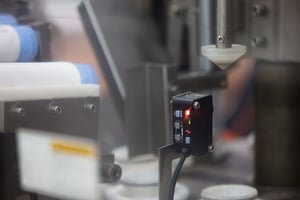 What is a Photoelectric Sensor?
What is a Photoelectric Sensor?
Photoelectric sensors are able to detect objects using a light transmitter and a photoelectric receiver. These sensors can assess their surroundings and process the distance of an object and recognize if the object is nearby or absent. Also referred to as the “Photo Eye”, these systems detect a change in light instantly and can easily be incorporated into a variety of different equipment. There are three main ways photoelectric sensors utilize target detection; through-beam, retro-reflective, and proximity or diffused mode.
Through-beam:
 Through-beams are the most accurate type of photoelectric sensors. However, the transmitter and receiver need to be installed in two different systems. The transmitter and receiver are placed apart from each other with one containing the light emitter and the other housing the receiver. If an object was to break that shared light between those two systems, the machine will sense a disturbance and change its process. This is used in environments where there is dirt and other visually impairing surroundings. This system can identify small particles easily, has an accurate and precise object location capability, and can recognize contents within a container. This method allows for the most extended sensing ranges possible, making it the most efficient type of mode.
Through-beams are the most accurate type of photoelectric sensors. However, the transmitter and receiver need to be installed in two different systems. The transmitter and receiver are placed apart from each other with one containing the light emitter and the other housing the receiver. If an object was to break that shared light between those two systems, the machine will sense a disturbance and change its process. This is used in environments where there is dirt and other visually impairing surroundings. This system can identify small particles easily, has an accurate and precise object location capability, and can recognize contents within a container. This method allows for the most extended sensing ranges possible, making it the most efficient type of mode.
Retro-reflective:
 Reflective Sensors are less costly than a through-beam, but their accuracy is slightly less than through-beam sensors. The transmitter and receiver in reflective sensors use a reflector to bounce light back from the transmitter to receiver. When an object is detected, it will interrupt the reflective light from the transmitter, and that system will be alerted and respond accordingly. These sensors typically have a more comprehensive sensing range as opposed to diffused sensors. This type of photoelectric sensor is utilized for detecting large objects, noticing objects moving at accelerated rates, and seeing transparent objects. To detect transparent objects, these sensors use hysteresis circuit that can identify minute changes in light.
Reflective Sensors are less costly than a through-beam, but their accuracy is slightly less than through-beam sensors. The transmitter and receiver in reflective sensors use a reflector to bounce light back from the transmitter to receiver. When an object is detected, it will interrupt the reflective light from the transmitter, and that system will be alerted and respond accordingly. These sensors typically have a more comprehensive sensing range as opposed to diffused sensors. This type of photoelectric sensor is utilized for detecting large objects, noticing objects moving at accelerated rates, and seeing transparent objects. To detect transparent objects, these sensors use hysteresis circuit that can identify minute changes in light.
Proximity-sensing or diffused:
Proximity sensors use electromagnetic beams to detect when an object is close in relation to the device’s surroundings. In this device, the light source and receiver are inside the same housing unit, unlike reflective and through-beam sensors. Here the transmitter must reflect off the object to align with the rec eiver. This system will detect an object when the receiver acknowledges the transmitted derivation. There are definite advantages to proximity sensors. These types of sensors can identify multiples, they can recognize what an object actually is by one specific characteristic, and they are able to detect a transparent object as well. This type of sensor doesn’t need a separate receiver or reflector to function; rather, it is compact and self-contained.
eiver. This system will detect an object when the receiver acknowledges the transmitted derivation. There are definite advantages to proximity sensors. These types of sensors can identify multiples, they can recognize what an object actually is by one specific characteristic, and they are able to detect a transparent object as well. This type of sensor doesn’t need a separate receiver or reflector to function; rather, it is compact and self-contained.
Photoelectrical sensors are becoming increasingly relied upon as manufacturing practices become more automated. While expanding productivity, these systems also create safe and efficient operations. They are metaphorically the eyes of the process by determining the change of light intensity and then correspondingly taking the proper action. These machines can sense potential danger and immediately shut done or avoid an operation. These sensors are used in everyday equipment like smoke alarms, garage doors, and automated devices. Each sensor has its own advantages in a given situation. This then makes the best sensor dependent on the specific location in which it is needed.
For more information about how Radwell can assist with your photoelectric sensor product needs and repairs or to learn more about the many industrial automation products and services we offer


